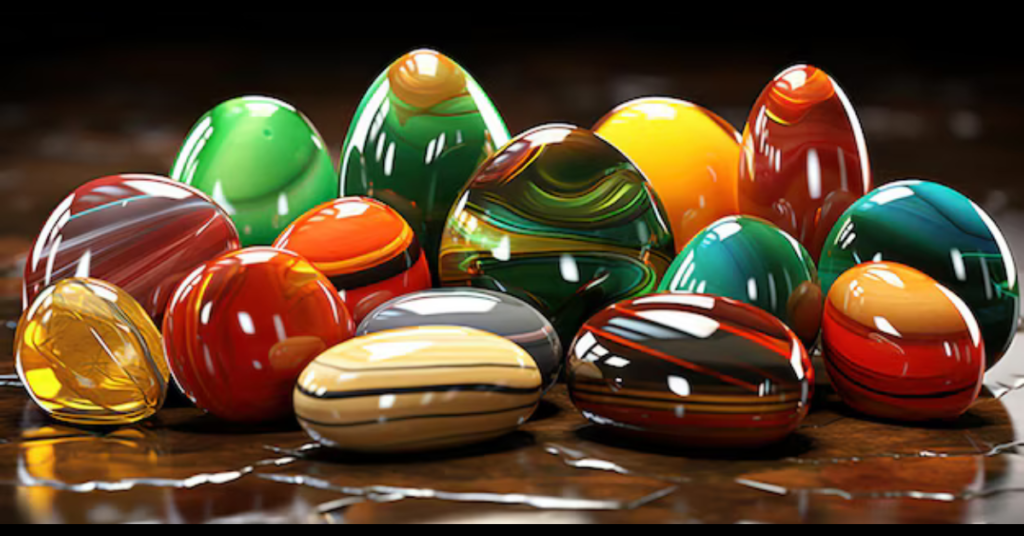Opalite, a beautiful and ethereal gemstone, has captured the fascination of jewelry enthusiasts, collectors, and holistic practitioners alike. Known for its unique appearance and metaphysical properties, opalite is often associated with transformation, healing, and emotional balance. This comprehensive guide explores the origins, characteristics, types, uses, and significance of opalite in various contexts, including its role in jewelry, alternative healing practices, and cultural symbolism.
1. What is Opalite?
1.1 Definition and Composition
Opalite is a man-made glass stone that resembles opal, featuring a translucent appearance with a soft, opalescent glow. Although it is not a natural mineral like traditional opals, opalite is often categorized as an opal substitute due to its visual similarities. The gemstone is created through a combination of silica and other materials, which give it its unique coloration and shimmering effects.
1.2 Varieties of Opalite
Opalite’s comes in various colors, including blue, green, white, and orange. Each variety is characterized by its distinct opacity and color depth. While the most commonly seen opalite is blue, which exudes a calming aura, other colors also hold their unique meanings and metaphysical properties.
2. The Origins of Opalite
2.1 Historical Context
Opalite has a relatively recent history compared to other gemstones. Although opal has been revered for centuries, opalite’s emerged in the late 20th century as a synthetic alternative. Its creation was a response to the demand for affordable gemstones that still offered beauty and metaphysical properties.
2.2 Geographical Sources
Since opalite’s is a man-made gemstone, it is not mined from natural deposits like other stones. Instead, it is manufactured in laboratories, primarily in the United States and China. The production process involves heating and shaping the silica mixture to achieve the desired appearance.
3. Physical and Chemical Properties
3.1 Appearance
Opalite’s is recognized for its enchanting beauty. Its surface often exhibits a pearly sheen, with colors ranging from milky white to vivid blue and subtle pastels. The opalescent effect, which changes with light, gives it a dynamic quality that many find captivating.
3.2 Hardness and Durability
On the Mohs scale of mineral hardness, opalite’s typically ranks between 5.5 and 6.5, making it relatively soft compared to more durable gemstones like sapphire or diamond. This softness means opalite requires careful handling to prevent scratches or damage.
3.3 Care and Maintenance
To maintain opalite’s beauty, it is essential to clean it gently with warm, soapy water and a soft cloth. Avoid harsh chemicals and ultrasonic cleaners, as these can damage the stone’s surface. Proper storage in a soft pouch or jewelry box can also help protect it from scratches.
4. Metaphysical Properties of Opalite
4.1 Spiritual Significance
Opalite is often associated with spiritual awakening and transformation. It is believed to enhance communication, both with oneself and others, facilitating emotional healing and self-expression. Many practitioners use opalite to promote clarity of thought and encourage emotional stability.
4.2 Healing Properties
Opalite is widely regarded for its healing properties, particularly in alternative and holistic healing practices. It is thought to support the throat chakra, aiding in effective communication and expression of one’s thoughts and feelings. Additionally, opalite is believed to help alleviate anxiety and stress, making it a popular choice for meditation and mindfulness practices.
4.3 Uses in Meditation and Energy Work
Many spiritual practitioners incorporate opalite into meditation practices to enhance spiritual growth and clarity. Holding or placing opalite on the body during meditation sessions can help individuals connect with their inner selves and promote a sense of peace. Additionally, opalite is often used in energy healing modalities, such as Reiki, to balance energies and facilitate emotional healing.
5. Opalite in Jewelry
5.1 Popular Jewelry Designs
Opalite’s is a popular choice for jewelry due to its captivating appearance and metaphysical properties. Common jewelry designs featuring opalite include:
- Necklaces: Opalite pendants or beads are often used in necklaces, creating a beautiful focal point that can be worn every day or for special occasions.
- Earrings: Opalite stones are often set in earrings, providing a subtle pop of color and sparkle.
- Bracelets: Opalite beads are frequently used in bracelets, either as a single strand or combined with other gemstones to create unique designs.
- Rings: Opalite’s rings can be found in various styles, from simple solitaire designs to intricate settings.
5.2 Choosing Opalite Jewelry
When selecting opalite jewelry, consider factors such as color, clarity, and craftsmanship. Look for pieces that resonate with you, as personal connection is essential in choosing gemstones. Ensure that the jewelry is well-made and features quality opalite stones to ensure durability and longevity.
6. Cultural Significance of Opalite
6.1 Symbolism Across Cultures
Opalite’s has garnered various meanings and associations across different cultures. While it is primarily recognized in contemporary contexts, some cultures attribute specific symbolic meanings to opal-like stones, such as hope, purity, and transformation. In many spiritual circles, opalite’s symbolizes emotional healing and spiritual growth.
6.2 Use in Rituals and Ceremonies
In some spiritual practices, opalite’s is used in rituals to enhance clarity and communication. It may be incorporated into ceremonies focused on personal transformation, emotional healing, or spiritual awakening. Practitioners often use opalite as a tool to amplify intentions and energies during these ceremonies.
7. The Science of Opalite
7.1 Manufacturing Process
The creation of opalite involves a precise manufacturing process. The base materials, typically silica and other additives, are heated and mixed to form a viscous glass-like substance. This mixture is then shaped into desired forms, such as beads or cabochons, and cooled to create the final opalite product.
7.2 Chemical Composition
Opalite’s primarily consists of silica, with additional components that give it its unique colors and optical properties. The precise chemical formula may vary depending on the manufacturer and desired characteristics.
8. Opalite vs. Other Gemstones
8.1 Comparison with Natural Opal
While opalite’s shares visual similarities with natural opal, it is essential to understand the differences between the two. Natural opal is a mineraloid that forms through a specific geological process, while opalite’s is a man-made glass stone. Natural opal often exhibits a more complex play of color and has unique inclusions, making it highly sought after and valued in the gemstone market.
8.2 Other Synthetic Gemstones
Opalite’s is one of many synthetic gemstones available on the market. Other examples include cubic zirconia and moissanite, both of which serve as affordable alternatives to traditional gemstones. Each synthetic stone has its unique properties and applications, catering to different consumer preferences.
9. The Market for Opalite
9.1 Popularity and Demand
Opalite’s has gained popularity in recent years, particularly among those interested in alternative healing practices and holistic lifestyles. Its affordability and unique appearance make it an attractive choice for consumers seeking beautiful gemstones without the high price tags often associated with natural stones.
9.2 Market Trends
As the demand for opalite’s grows, various trends have emerged within the market. Many artisans and jewelers are incorporating opalite into their designs, leading to a diverse range of jewelry styles. Additionally, the rise of online shopping has made it easier for consumers to access a wide variety of opalite’s products.
10. Buying Opalite: Tips for Consumers
10.1 Where to Purchase
Opalite’s can be found in various retail settings, including jewelry stores, metaphysical shops, and online marketplaces. When purchasing opalite, consider reputable sellers that provide information about the gemstone’s origin and quality.
10.2 Evaluating Quality
When buying opalite, evaluate factors such as color, clarity, and craftsmanship. High-quality opalite’s should exhibit vibrant colors, a smooth surface, and minimal inclusions. If purchasing jewelry, ensure that the setting is secure and well-crafted to protect the stone.
10.3 Understanding Pricing
Opalite’s is generally more affordable than natural gemstones, making it accessible to a broader audience. Pricing may vary depending on factors such as size, quality, and craftsmanship. Compare prices from different sellers to ensure you are getting a fair deal.
11. Care and Maintenance of Opalite
11.1 Cleaning Techniques
To keep opalite’s looking its best, it is essential to clean it regularly. Use a soft cloth and mild soap to gently wipe the surface. Avoid using harsh chemicals, as they can damage the stone’s finish.
11.2 Storage Recommendations
When not in use, store opalite jewelry in a soft pouch or jewelry box to prevent scratches. Keeping opalite away from direct sunlight and extreme temperatures can help preserve its beauty.
12. Conclusion
Opalite’s is a captivating gemstone that has garnered attention for its beauty and metaphysical properties. From its origins as a man-made alternative to opal to its role in jewelry and healing practices, opalite’s continues to enchant and inspire individuals around the world. Whether used in meditation, worn as jewelry, or appreciated for its aesthetic appeal, opalite offers a unique blend of transformation, healing, and emotional balance.
As interest in alternative healing practices and holistic lifestyles grows, opalite’s is likely to remain a popular choice for those seeking beauty and meaning in their gemstones. Its affordability, versatility, and enchanting appearance make it a valuable addition to any collection. Embracing opalite’s can enhance not only one’s personal style but also foster emotional well-being and spiritual growth, making it a true gem in every sense.







